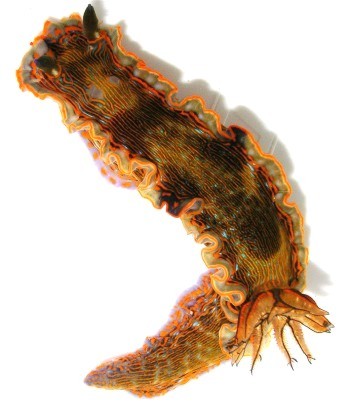
Hypselodoris juliae
Dacosta, Padula & Schroedl, 2010
Order: NUDIBRANCHIA
Suborder: DORIDINA
Superfamily: EUDORIDOIDEA
Family: Chromodorididae
DISTRIBUTION
Hypselodoris juliae has been reported only from near Rio de Janeiro, Brazil. However I have little doubt that Hypselodoris sp. 4 is conspecific. If that proves to be the case then H. juliae, has a range from Brazil to Florida.
PHOTO
Upper Photo: Holotype. MNRJ 10940, 57 mm alive, Praia das Conchas, Cabo Frio, state of Rio de Janeiro, Brazil, intertidal, 14 November 2004. Photo: V. Padula.
Tha animal is elongate with a relatively narrow mantle skirt down each side. The edge of the mantle is sinuously folded. The mantle is translucent with a purplish or greyish tinge. There are many thin yellow to orange longitudinal lines running down the mantle and along the sides of the body and foot. There is an orange/yellow line at the mantle edge, bordered both above and below by a thin opaque white line. Inside this border is a wide translucent grey/purple submarginal space before the longitudinal oral lines. In this space a single spaced row of whitish subepidermal mantle glands can be seen running around the mantle edge.
The longitudinal orange lines are each edged thin dark brown line. There are also a number of irregular dark brown patches arrange on the mantle, About midway between the gills and the rhinophores there is a dark brown patch on each side at the mantle edge. It contains a number of orange/yellow spots. The edge of the foot is translucent purple or grey with scattered orange spots and short lines.
There are approximately 10 simple gills. They are translucent whitish with a dark brown edge. In some cases the upper edge also has a submarginal orange/yellow line as well. The rhinophore clubs are translucen with varying degrees of dark brownish pigment, sometimes making the whole club brown while other time the brown is restricted to bands at the tip.
While the authors have some doubts about whether Hypselodoris sp. 4 is conspecific, I feel there is little doubt it is the same species. If that proves to be the case then H. juliae, reported only from near Rio de Janeiro, Brazil, has a range from Brazil to Florida, where Hypselodoris sp. 4 has been found.
Previously known on the Forum as Hypselodoris sp. 4.
- Dacosta, S., Padula, V. & Schroedl, M. 2010 A New Species of Hypselodoris and a Redescription of Hypselodoris picta lajensis (Nudibranchia: Chromodorididae) from Brazil. The Veliger, 51: 15-25
Rudman, W.B., 2010 (May 31) Hypselodoris juliae Dacosta, Padula & Schroedl, 2010. [In] Sea Slug Forum. Australian Museum, Sydney. Available from http://www.seaslugforum.net/find/hypsjuli
Related messages
Hypselodoris juliae from Brazil [2]
June 3, 2010
From: Peter Wirtz

Concerning message #23701:
My photo of Hypselodoris juliae was taken at the wreck of the "Victory" off Guarapari, Espirito Santo, Brazil, in about 20 m depth.
Cheers !
Peter
peterwirtz2004@yahoo.com
Wirtz, P., 2010 (Jun 3) Hypselodoris juliae from Brazil [2]. [Message in] Sea Slug Forum. Australian Museum, Sydney. Available from http://www.seaslugforum.net/find/23702Thanks Peter,
Your animals also shows the 'mantle glands' in the gills very clearly
Best wishes
Bill
Hypselodoris juliae from Brazil [1]
May 31, 2010
From: Vinicius Padula
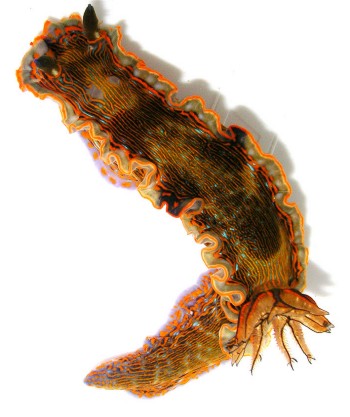
Dear Bill,
Here are some photos of a new species of Hypselodoris from Brazil - Hypselodoris juliae. The new species is similar to Hypselodoris sp.4, but has a different color pattern (variations of a same species or already isolated biological entities?).
Interesting, Hypselodoris juliae has glands similar to MDF [mantle glands] on the gill tissue. They are not clear in the holotype, but occur in the paratype and are visible on an additional specimen photographed near the type locality ( photo).
Upper Photo: Holotype. MNRJ 10940, 57 mm alive, Praia das Conchas, Cabo Frio, state of Rio de Janeiro, Brazil, intertidal, 14 November 2004. Photo: V. Padula. Lower Photos: Specimen from near type location, close-ups showing everted oral tube, and glands in gills. Photo: Felipe Kuhnert
Best,
Vinicius Padula
viniciuspadula@yahoo.com
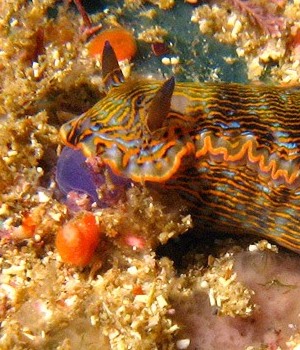
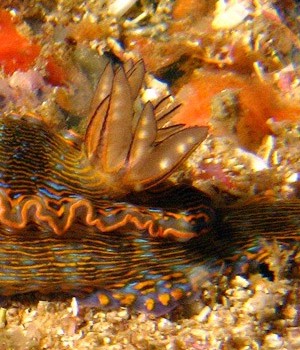
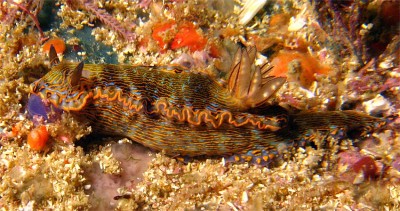
Dear Vinicius,
Thanks very much for these photos. I am more confident than you that Hypselodoris sp. 4 is indeed this new species. Even the conspicuous white glands in the gills can be seen in most of the animals I have called Hypselodoris sp. 4, although I mistakenly suggested they were white spots along the edge of the gill in one case. The yellow to orange lines on the mantle, mantle edge and sides of the body, the darker blotches on the mantle, and the dark patch midway down the mantle on each side with orange spots, are all characteristic, even if the shades of yellow and orange vary.
The glands in the gills are very conspicuous. They seem to be present in many chromodorids - and other dorids for that matter - but I don't think anyone has done a review of them across the dorids. From my experience, their presence doesn't seem to be consistent - some animals of a species may have them while others don't. This could mean their presence is cyclic, but unfortunately I don't think we know. If anyone has any relevant references, they would be welcome.
Best wishes,
Bill Rudman
Hypselodoris sp. 4 - Post Mating
May 16, 2003
From: Linda Ianniello
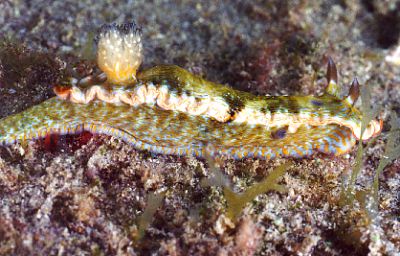
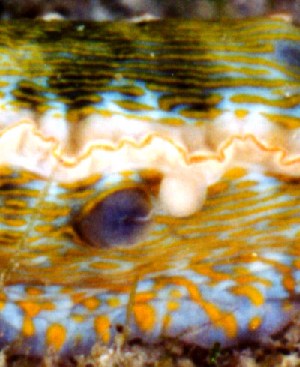
Note added 31 May 2010: This species has recently been named H. juliae.
Dr. Bill,
I am probably going to blush when you post the answer to this question, but attached are 2 photos of a Hypselodoris sp. 4 after mating. What is the "bead" that is visible dangling by a "thread" from its "organ"? After mating, neither slug proceeded to lay eggs - they both headed back to their food sponge which was a couple of feet away.
Also, I sent in a picture some time ago of eggs laid by this species in a clump of algae. It was the only time I had seen eggs, even though we see the slugs frequently. This past weekend I found more eggs, laid in the same type of algae, about 1.5 feet from their blue sponge food. It is interesting that they don't appear to lay their eggs on or near their food, but in that particular algae, where they are not very visible even though they are a very bright color.
Regards,
Linda I.
Lindai@us.ibm.com
Ianniello, I., 2003 (May 16) Hypselodoris sp. 4 - Post Mating. [Message in] Sea Slug Forum. Australian Museum, Sydney. Available from http://www.seaslugforum.net/find/9870Thanks Linda,
It would be interesting to build up some information on where different species lay their eggs. Certainly those with direct development often lay their eggs on their food which I guess means that the small juveniles can crawl out of their egg capsule straight on to the dinner table. A very usful adaptation if your are very small.
Concerning the white 'bead' in the second photo - I hope I can be delicate enough to save you a blush. It looks very much like a compacted bundle of sperm from one of the two sperm sacs these animals have. We don't know much about the mechanics of mating in opisthobranchs so anything I say from now on I am making up. I remember reading recently about mating in the garden snail Helix aspersa - native to Europe and an introduced pest in many other parts of the world. Like sea slugs, land snails are also hermaphrodites, so a comparison with t hem is nnot so out of place. Heliz aspersa is one of a number of snails tha stab their partner during mating with a calcareous dart - often called a 'love dart'. The function of this dart remains a mystery, but one recent suggestion is that it stimulates muscle contractions which cause sperm from earlier matings to be expelled from the snail, so that the sperm of the present partner does nnot have to compete with sperm from earlier matings. Whether this nice theory can be shown to be the case or not, it does raise the possibility that if this is a ball of sperm, it has been expelled by the slug for some reason.
Best wishes,
Bill Rudman
Hypselodoris sp. 4 eggs
September 27, 2002
From: Linda Ianniello


Note added 31 May 2010: This species has recently been named H. juliae.
Dr. Bill,
Here is a shot of the eggs of Hypselodoris sp. 4. We have been observing this species frequently over the past year, at this same location, but this is the first time I have ever seen any eggs. Which is even more surprising since they are so bright! The first shot shows the eggs with the Hypselodoris in the same algae; since it wasn't actually laying the eggs I recorded that it was right there, along with a tiny crab. The second shot is a close-up of the eggs only - without the crab. It is interesting that they feed on the blue sponge shown in my other submission, but these eggs were on algae some distance from any sponge.
Location: Deerfield Beach, Florida
Depth: about 10 feet
Recorded: July, 2002
Regards,
Linda Ianniello
lindai@us.ibm.com
Ianniello, L., 2002 (Sep 27) Hypselodoris sp. 4 eggs. [Message in] Sea Slug Forum. Australian Museum, Sydney. Available from http://www.seaslugforum.net/find/7816Thanks Linda,
The eggs are indeed a bright colour. Have you actually seen them laying them? It would be an interesting study to see whether some species lay their eggs on their food sponge and others do not. From my experience, most species seem to sometimes lay them on their food and other times don't, but I have never the sort of comprehensive and systematic observations which would be required.
Best wishes,
Bill Rudman.
Food of Hypselodoris sp. 4
October 6, 2001
From: Anne DuPont
Note added 31 May 2010: This species has recently been named H. juliae.
Dear Bill,
I asked Professor Joe Pawlik, who amongst other things is resarching the chemical defenses of sponges at University of N. carolina, Wilmington, if he could identify the sponge we found Hyspselodoris sp. 4 on.
He has replied saying:
"It's most likely Dysidea etheria [which] seems to be the primary food of Hypselodoris zebra in Bermuda and throughout the Caribbean."
Joe Pawlik
pawlikj@uncwil.edu
http://www.uncwil.edu/people/pawlikj/index.html
Anne.
akdupont@bellsouth.net
Anne DuPont, 2001 (Oct 6) Food of Hypselodoris sp. 4. [Message in] Sea Slug Forum. Australian Museum, Sydney. Available from http://www.seaslugforum.net/find/5411Dear Anne,
Thanks for following up the identification. Species of Dysidea are one of the favourite foods of chromodorids so it is not surprising that more than one species in the Caribbean is feeding on Dysidea etheria.
Best wishes,
Bill Rudman
Re: Hypselodoris sp. 4 from Florida
October 5, 2001
From: Linda Ianniello
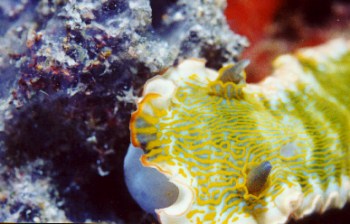
Note added 31 May 2010: This species has recently been named H. juliae.
Hi Bill,
Here is a followup to Anne DuPont's earlier message with photos of the Hypselodoris and its sponge. It shows the inflated sac-like oral tube that you mentioned in your update would be visible when they were feeding. I thought you might be interested in seeing the photo.
Regards,
Linda Ianniello
lindai@us.ibm.com
Ianniello, L. , 2001 (Oct 5) Re: Hypselodoris sp. 4 from Florida. [Message in] Sea Slug Forum. Australian Museum, Sydney. Available from http://www.seaslugforum.net/find/5397Dear Linda,
Thanks for this great photo - it certainly shows what I said to look out for if you want evidence of a sponge-feeder at work. Your photo also shows how the yellow lines on the mantle can form a reticulate pattern, reminiscent of H. acriba, at least at the head end of the body. Whether this is a peculiar form of H. acriba or not is an interesting puzzle. I guess it's another little mystery to store up for later investigation. Some photos of intermediate colour forms, or diferent colour forms mating etc, would of course be very welcome.
Best wishes,
Bill Rudman
Food of Hypselodoris sp. 4
September 25, 2001
From: Anne Dupont
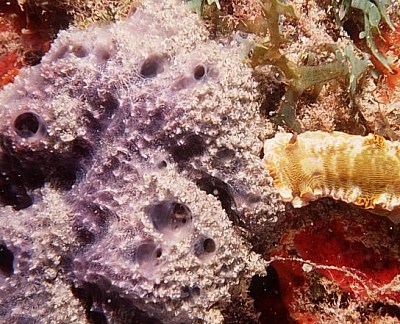
Note added 31 May 2010: This species has recently been named H. juliae.
Dear Bill,
Here is another photo of the animal in the earlier message showing the sponge it is feeding on more clearly.
[Sunday, September 16, 2001, in 12 feet of water off Boca Raton, Florida, USA].
Best regards,
Anne
akdupont@bellsouth.net
Dupont, A., 2001 (Sep 25) Food of Hypselodoris sp. 4. [Message in] Sea Slug Forum. Australian Museum, Sydney. Available from http://www.seaslugforum.net/find/5334Dear Anne,
Thanks again Anne. I am sure a sponge expert would be able to identify the sponge from your photo. If it was in the Indo-West Pacific I would suggest it is a species of Dysidea.
Best wishes,
Bill Rudman
Hypselodoris acriba or H. edenticulata?
September 25, 2001
From: Anne DuPont
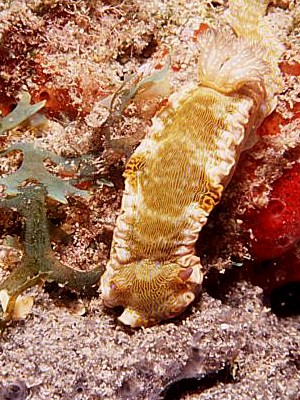
Note added 31 May 2010: This species has recently been named H. juliae.
Dear Bill,
Here is a follow-up on my earlier photos of an animal which could have been Hypselodoris acriba or H. edenticulata.
On Sunday, September 16, 2001, I was able to dive the site where we have found the earlier specimen of Hypselodoris sp. in 12 feet of water off Boca Raton, Florida.
We were very fortunate to find 4! One small pair together mating? [Lower photos]. One larger one close by with its head in a hole. nd one feeding(?) on the purple sponge [Upper right photo; see also separate message]. This is the same sponge that I was telling you about from the first sighting. Hopefully these 4 photographs will give you more insight into identifying it.
To give you some background information on our finds, shortly after entering the water my dive buddy found the pair together (mating?) along side the larger one with its head in the hole. They were together for a short while, and then came apart, and one crawled off. About 15 feet down the little ledge, we found the 4th one who was eating on the blue sponge.
After photographing it eating, we went to other parts of the reef looking for another nudibranch. After about 80 minutes, we came back to the 4 nudibranchs. The pair were together again, (mating?) and the big one still had its hole in the reef, and the 4th one was still eating away!
Best regards,
Anne
Delray Beach, Florida, USA
akdupont@bellsouth.net
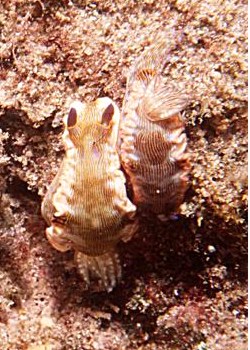

Thanks Anne,
For these wonderful photos. What a delight it must have been to go back to the same spot and find these animals again. Firstly about their biology. I am pretty sure they are mating - or at least seriously considering it! And I am also pretty sure they are feeding. To have their heads stuck like this for 80 minutes or so suggests they were doing something, and the chance of finding them with the same sponge as last time, just by coincidence, doesn't seem very high. One way to check if any of these dorids are feeding is the gently push their head aside. While you won't see them actually munching away you will almost certainly see the inflated sac-like oral tube which everts out of the mouth to bring the teeth in contact with the food. If that is visible its a good sign that feeding has been taking place.
Concerning its identity. I can really only repeat what I said in reply to your earlier message. It doesn't seem to be the H. edenticulata form of H. picta, or H. acriba or H. ruthae. Two characteristic features of your species seem to be the dark patch at the edge of the mantle about half way down each side, and the white spots on the gills. if you look at Dave Behren's photo of H. acriba you can see a similar dark patch at the mantle edge. This is not mentioned in the original description of the species but is clear in this photo. One of the major differences between the two is that in H. acriba the yellow lines on the mantle form a reticulate network while in your animal they form a series of longitudinal lines. However if you look closely at the head of the animal in your upper right photo you can see the lines form a reticulate pattern.
I guess we will have to wait until more is known about these animals, perhaps they are closely related but distinct species, perhaps they are extreme forms of one species. If it is a distinct species, it would appear to be unnamed.
Best wishes,
Bill Rudman.
Hypselodoris acriba or H. edenticulata
August 21, 2001
From: Anne DuPont
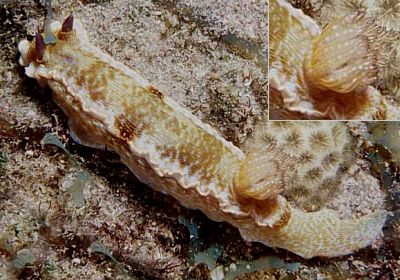
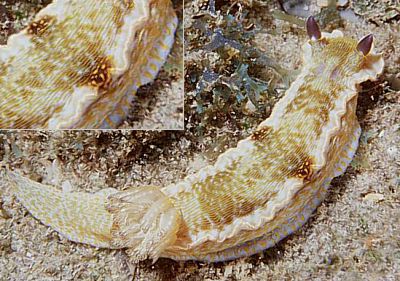
Note added 31 May 2010: This species has recently been named H. juliae.
Hi Bill,
Is this a color form of Hypselodoris picta edenticulata? or is it Hypselodoris acriba?
It was photographed off Boca Raton, Florida, USA, in about 10 feet of water on the sand. This one was about 2 1/2 inches long and was very active. We also found a pair about 1 inch each long on a purple sponge. Photographed on July 29, 2001.
Thank you again for all the work you do on the forum.
Cordially,
Anne DuPont
adupont@gate.net
DuPont, A., 2001 (Aug 21) Hypselodoris acriba or H. edenticulata. [Message in] Sea Slug Forum. Australian Museum, Sydney. Available from http://www.seaslugforum.net/find/5111Dear Anne,
Thanks very much for sending these interesting photos. Did you by chance photograph it on the purple sponge as well? That would be really interesting. It certainly looks like the animal identified in Paul Humann's book as Hypselodoris acriba but that photo is rather different from the published description of H. acriba which is of an animal much like Dave Behren's photo on the Forum. One distinctive feature in your photos are the dark patches midway down each side on the mantle with yellow spots. These spots aren't present in Behren's photo or mentioned by the Marcuses in the original description. Also Marcus describes the gills as having 'bases of gills brick red, tips yellowish' which is the same as Behren's photo. In your photo the gills are translucent clear with a row of white spots up the outer rachis. The gills also seems to have branched purplish tips.
Checking the literature, what really amazes me is that we know so little about Hypselodoris acriba. It was described on a single preserved specimen and almost no other published record exists with any information on colour variation etc. It is the same with Hypselodoris ruthae and almost every chromodorid from the west Atlantic.
Basically this may be H. acriba but unless someone with a lot of unpublished knowledge can give us some advice on its colour variation, I really can't say much more.
Best wishes,
Bill Rudman
